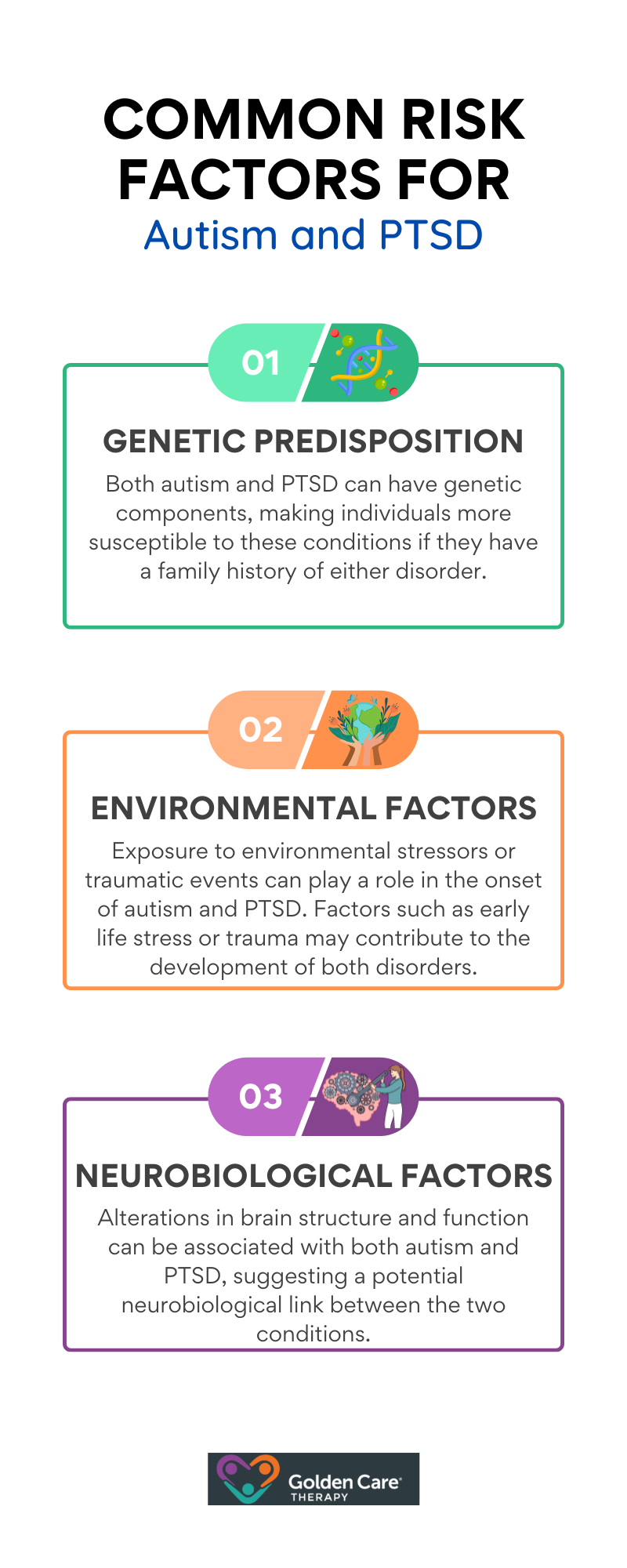Living with autism can already bring its own unique set of challenges, but for some, there’s another layer to navigate: Post-Traumatic Stress Disorder (PTSD). While these two conditions may seem very different, they can overlap in ways that make life even more difficult.
The experience of PTSD can add complexity to the way someone with autism reacts to the world around them, affecting their emotions, behaviors, and daily routines. Understanding how autism and PTSD can occur together is crucial for providing the right support and care for those who face both.
Can Autism and PTSD Occur Together?
Yes, autism and PTSD can occur together. Individuals with autism can experience trauma, just like anyone else, which may lead to the development of PTSD.
Autism primarily affects social communication and behavior, while PTSD is a mental health condition triggered by a traumatic event. When combined, the challenges of both conditions can make it more difficult to recognize symptoms and manage everyday life.
Having autism does not make someone immune to PTSD, and people with autism may be more vulnerable to certain types of trauma due to heightened sensory sensitivities, communication difficulties, and struggles with social interaction.
Individuals with both autism and PTSD should receive tailored support to address both conditions, focusing on trauma-informed care and strategies to manage the symptoms of both autism and PTSD.
That said, the co-occurrence of autism and PTSD is a complex phenomenon that can present unique challenges. Individuals with autism may have a higher risk of experiencing traumatic events due to difficulties in social communication and interactions. For those with both autism and ADHD, commonly referred to as AuDHD, the interplay of these conditions can further intensify these challenges, requiring tailored approaches to support and intervention.
Moreover, the symptoms of PTSD in individuals with autism may manifest differently or be more challenging to recognize.
Common Risk Factors for Autism and PTSD
Autism and PTSD share some common risk factors that may contribute to the development or exacerbation of these conditions. While each disorder is distinct, certain factors overlap and can increase the likelihood of both autism and PTSD occurring together.
These factors are as follows:

Individuals with autism may be particularly vulnerable to certain triggers that can lead to the development of PTSD. Understanding these triggers is crucial in identifying and addressing potential sources of trauma for individuals on the autism spectrum.
These triggers involve the following:
- Sensory Overload: Individuals with autism often have heightened sensory sensitivity, and overwhelming sensory stimuli can trigger feelings of distress and anxiety, potentially leading to PTSD symptoms.
- Changes in Routine: Disruptions in routine or unexpected changes can be distressing for individuals with autism, increasing the risk of experiencing traumatic events that may lead to PTSD.
- Social Challenges: Difficulties in social interactions and communication, common in autism, can expose individuals to situations that may result in traumatic experiences, contributing to the development of PTSD.
Recognizing the common risk factors and triggers associated with both autism and PTSD allows caregivers and individuals to take proactive steps to mitigate potential risks and provide appropriate support to manage these complex and interconnected conditions.

Diagnosis and Treatment
Diagnosing autism and PTSD can be complex, particularly when presented together. The symptoms of these disorders can overlap, leading to difficulties in accurately differentiating between the two.
Additionally, individuals with autism may find it challenging to express their thoughts and emotions, further complicating the assessment process.
To add to the complexity, PTSD symptoms in individuals with autism may manifest differently than in neurotypical individuals. This can lead to misinterpretation or underrecognition of PTSD symptoms, delaying the appropriate diagnosis and intervention.
Treating the comorbidity of autism and PTSD requires a multifaceted approach that addresses the unique needs of each individual. Behavioral therapies, such as Applied Behavior Analysis (ABA) and Cognitive Behavioral Therapy (CBT), have shown promise in managing symptoms associated with both disorders.
In addition to behavioral interventions, a comprehensive treatment plan may include medication, sensory integration therapy, and social skills training. Healthcare providers need to collaborate closely with individuals with autism, their families, and other caregivers to tailor treatment strategies to the specific challenges presented by the co-occurrence of autism and PTSD.
Furthermore, creating a supportive and accommodating environment is key to the success of the treatment process. Implementing structure, routine, and sensory-friendly practices can help individuals with autism and PTSD feel more secure and supported in their daily lives.
Through a holistic approach that takes into account the nuances of both autism and PTSD, individuals can receive the necessary support and interventions to effectively manage their symptoms and improve their overall quality of life. Golden Care Therapy offers specialized ABA therapy that focuses on personalized care, ensuring each individual receives tailored strategies that promote growth and development.
We proudly provide autism services in New York, New Jersey, Indiana, Georgia, and Florida. Contact us today to learn more about how our compassionate team can support you or your loved one in reaching their full potential.
Sources:



